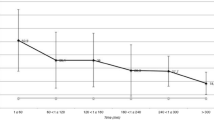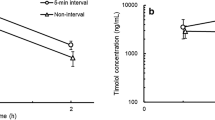Abstract
Concentrations of metipranolol were determined in the aqueous humour of patients undergoing cataract surgery. At 30 min before the operation, patients were given 20- or 30 μl drops of 0.1 % or 0.3% metipranolol solutions with a viscosity of 7.5 cP or drops (20 or 30 μl) of a 0.3% solution with a viscosity of 1.5 cP. Samples of the aqueous humour were obtained at the beginning of the cataract operation, and desacetylmetipranolol content was determined by means of gas chromatography and mass spectroscope. The Wilcoxon signed-rank test and Jonckheere's method were used for evaluation of the results. A 3-fold increase in the strength of metipranolol was associated with an approx. 8-fold increase in the concentration of metabolite found in the aqueous humour. Drop size had no apparent effect on the concentration of this substance in the aqueous humour, but viscosity had a significant influence when large drops were applied. An increase in the amount of metipronolol applied as eye-drops was associated with an increase in the intraocular concentration of the metabolite.
Similar content being viewed by others
References
Bartsch W, Sponer G, Strein K (1983) Pharmakologisches Spektrum des Metipranolol und Erfahrungen der klinischen Anwendung. In: Merte HJ ed (Hrsg) Metipranolol — Pharmakologie der Betablocker und Ophthalmologische Anwendung von Metipranolol. Springer, Wien New York, pp 35–49
Chrai SS, Patton TF, Mehta A, Robinson JR (1973) Lacrimal and instilled fluid dynamics in rabbit eyes. J Pharm Sci 7(62):1113–1120
Chrai SS, Makoid MC, Eriksen STP, Robinson JR (1974) Drop size and initial dosing frequency problems of topically applied ophthalmic drugs. J Pharm Sci 3(63):333–338
Dolder R, Skinner FS (1983) Ophthalmika. Pharmakologie, Biopharmazie aund Galenik der Augenarzneimittel, 3. Auflage. Wissenschaftliche Verlagsgesellschaft, Stuttgart, pp 40, 335–337, 340–346
Engelmayr W, Krieglstein GK (1980) Pilokarpin — ein Jahrhundert in der Glaukomtherapie. Kaden, Heidelberg, pp 26–28, 38, 54
File RR, Patton F (1980) Topically Applied Pilocarpine — Human pupillary response as a function of drop size. Arch Ophthalmol 98:112–115
Fraunfelder FT (1976) Extraocular fluid dynamics: how best to apply topical ocular medication. Trans Am Ophthalmol Soc 74:457–487
Garraffo R, Lapalus P (1986) Determination of metipranolol and desacetylmetipranolol in aqueous humour of the rabbit eye by gas chromatography with electron-capture detection. J Chromatogr 383(1):201–205
Lederer CHM, Harold RE (1986) Drop size of commercial glaucoma medications. Am J Ophthalmol 101:691–694
Lotti VJ, LeDouarec JC, Stone CA (1984) Autonomic nervous system: adrenergic antagonists. In: Sears ML (ed) Pharmaocology of the eye. Springer, Berlin Heidelberg New York, pp 249–277
Maren N, Calissendorff BM (1985) Timolol in aqueous humour after topical administration. A pilot study. Acta Ophthalmol 63(4):415–417
Maurice DM, Mishima M (1984) Ocular pharmacokinetics. In: Sears ML (ed) Pharmacology of the eye. Springer, Berlin Heidelberg New York, pp 20–116
Noack E (1984) Pharmakologische Gesichtspunkte der Glaukom-Therapie mit Beta-Rezeptorenblockern. Vortrag am Institut für Pharmakologic, Universität Düsseldorf. Ophthalmothek 5, Dr. Mann Pharma, Berlin
Patton TF (1977) Pharmacokinetic evidence for improved ophthalmic drug delivery by reduction of the instilled volume. J Pharm Sci 7:1058–1059
Patton TF, Francoeur M (1978) Ocular bioavailability and systemic loss of topically applied ophthalmic drugs. Am J Ophthalmol 85:225–229
Patton TF, Robinson JR (1975) Ocular evaluation of polyvinyl alcohol vehicle in rabbits. J Pharm Sci 8(64):1312–1315
Phillips CI, Bartholomew RS, Kazi G, Schmitt CJ, Vogel R (1981) Penetration of timolol eye drops in to human aqueous humour. Br J Ophthalmol 65(9):593–595
Phillips CI, Bartholomew RS, Levy AM, Grove J, Vogel R (1985) Penetration of timolol eye drops into human aqueous humour: the first hour. Br J Ophthalmol 69(3):217–218
Ros FE, Innemee HE, Van Zwieten PA (1979) Ocular penetration of beta-adrenergic blocking agents: an experimental study with atenolol, metoprolol, timolol and propranolol. Doc Ophthalmol 48:291–301
Sugaya M, Nagataki S (1978) Kinetics of topical pilocarpine in the human eye. Jpn J Ophthalmol 22:127–141
Tang-Lui DD, Liu S, Neff F, Sandri R (1987) Disposition of levobunolol after [administration of an] ophthalmic dose to rabbits. J Pharm Sci 76(10):780–783
Trueblood JH, Rossoondo RM, Carlton WH, Wilson LA (1975) Corneal contact times of ophthalmic vehicles. Arch Ophthalmol 93:127–130
Author information
Authors and Affiliations
Additional information
Offprint requests to: H. Bleckmann
Rights and permissions
About this article
Cite this article
Keβler, C., Bleckmann, H. & Kleintges, G. Influence of the strength, drop size and viscosity of metipranolol eye drops on the concentration of the substance in human aqueous humour. Graefe's Arch Clin Exp Ophthalmol 229, 452–456 (1991). https://doi.org/10.1007/BF00166309
Received:
Accepted:
Issue Date:
DOI: https://doi.org/10.1007/BF00166309




